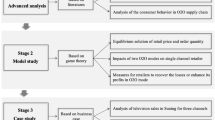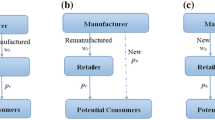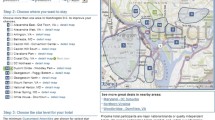Abstract
Demand information and consumer valuation uncertainty of new products have significant impacts on both consumers’ purchasing behavior and retail operations. To address the information transparency for new products launching, this study examines the profitability of omni-channel pre-ordering (i.e., compared to traditional online pre-ordering), a new advance selling strategy for retailers whereby consumers can solve product value uncertainty first and then decide whether to purchase in advance. Our analysis finds that advance selling is not always an appropriate choice for the retailer, but is contingent on related costs (e.g., losses from the costs of returns for retailers and consumers and the hassle cost of solving uncertain value for consumers). Specifically, only when the retailer’s return cost is relatively low and the hassle cost of solving uncertain value is relatively high should the retailer adopt the traditional online pre-ordering strategy. However, when the hassle cost of solving uncertain value is relatively low, the omni-channel pre-ordering strategy is more profitable for the retailer. By contrast, advance selling should not be offered when the retailer’s return cost and the hassle cost of solving uncertain value are both high. Next, we derive the optimal advance selling price and ordering quantity for the regular season for different strategies. Our results reveal that the optimal price varies along with the costs involved in the consumer’s purchasing choice. Finally, we find that the retailer is more likely to order a smaller quantity when the traditional online pre-ordering option is used.



Similar content being viewed by others
References
Altug, M. S., & Aydinliyim, T. (2016). Counteracting strategic purchase deferrals: The impact of online retailers’ return policy decisions. Manufacturing & Service Operations Management, 18(3), 376–392.
Balakrishnan, A., Sundaresan, S., & Zhang, B. (2014). Browse-and-switch: Retail-online competition under value uncertainty. Production and Operations Management, 23(7), 1129–1145.
Bell, D., Gallino, S., & Moreno, A. (2015). Showrooms and information provision in omni-channel Retail. Production and Operations Management, 24(3), 360–362.
Bell, D. R., Gallino, S., & Moreno, A. (2017). Offline showrooms in omnichannel retail: Demand and operational benefits. Management Science, 64(4), 1629–1651.
Bhargava, H. K., & Chen, R. R. (2012). The benefit of information asymmetry: When to sell to informed customers? Decision Support Systems, 53(2), 345–356.
Bickel, P. J., & Doksum, K. A. (1977). Mathematical Statistics. San Francisco, CA: Holden-Day.
Chen, J., & Bell, P. C. (2013). The impact of customer returns on supply chain decisions under various channel interactions. Annals of Operations Research, 206(1), 59–74.
Choi, T. M., & Guo, S. (2018). Responsive supply in fashion mass customisation systems with consumer returns. International Journal of Production Research, 56(10), 3409–3422.
Chou, M. C., Sim, C., & Yuan, X. (2020). Policies for inventory models with product returns forecast from past demands and past sales. Annals of Operations Research, 288, 137–180.
Chu, L. Y., & Zhang, H. (2011). Optimal preorder strategy with endogenous information control. Management Science, 57(6), 1055–1077.
Ferguson, M., Guide, V. D. R, Jr., & Souza, G. C. (2006). Supply chain coordination for false failure returns. Manufacturing & Service Operations Management, 8(4), 376–393.
Fernández, N. V., Pérez, M. J. S., & Vázquez-Casielles, R. (2018). Webroomers versus showroomers: Are they the same? Journal of Business Research, 92, 300–320.
Gao, F., & Su, X. (2016). Online and offline information for omnichannel retailing. Manufacturing & Service Operations Management, 19(1), 84–98.
Gao, F., & Su, X. (2019). New Functions of Physical Stores in the Age of Omnichannel Retailing. In Operations in an Omnichannel World (pp. 35–50). Cham: Springer.
He, Y., Xu, Q., & Wu, P. (2020). Omnichannel retail operations with refurbished consumer returns. International Journal of Production Research, 58(1), 271–290.
Karakayali, I., Akçalı, E., Çetinkaya, S., & Üster, H. (2013). Capacitated replenishment and disposal planning for multiple products with resalable returns. Annals of Operations Research, 203(1), 325–350.
Li, C., & Zhang, F. (2013). Advance demand information, price discrimination, and preorder strategies. Manufacturing & Service Operations Management, 15(1), 57–71.
Li, G., Li, L., Sethi, S. P., & Guan, X. (2019a). Return strategy and pricing in a dual-channel supply chain. International Journal of Production Economics, 215, 153–164.
Li, G., Li, L., & Sun, J. (2019b). Pricing and service effort strategy in a dual-channel supply chain with showrooming effect. Transportation Research Part E: Logistics and Transportation Review, 126, 32–48.
Li, G., Liu, M., Bian, Y., & Sethi, S. P. (2020a). Guarding against disruption risk by contracting under information asymmetry. Decision Sciences,. https://doi.org/10.1111/deci.12437.
Li, G., Zhang, X., Chiu, S., Liu, M., & Sethi, S. P. (2019c). Online market entry and channel sharing strategy with direct selling diseconomies in the sharing economy era. International Journal of Production Economics, 218, 135–147.
Li, G., Zheng, H., Sethi, S. P., & Guan, X. (2020b). Inducing downstream information sharing via manufacturer information acquisition and retailer subsidy. Decision Sciences, 51(3), 691–719.
Li, Y., Xu, L., Choi, T. M., & Govindan, K. (2014). Optimal advance-selling strategy for fashionable products with opportunistic consumers returns. IEEE Transactions on Systems, Man, and Cybernetics: Systems, 44(7), 938–952.
Liu, Q., & Van Ryzin, G. J. (2008). Strategic capacity rationing to induce early purchases. Management Science, 54(6), 1115–1131.
Ma, S., Li, G., Sethi, S. P., & Zhao, X. (2019). Advance selling in the presence of market power and risk-averse consumers. Decision Sciences, 50(1), 142–169.
Mehra, A., Kumar, S., & Raju, J. S. (2018). Competitive strategies for brick-and-mortar stores to counter ”showrooming”. Management Science, 64(7), 3076–3090.
Nasiry, J., & Popescu, I. (2012). Advance selling when consumers regret. Management Science, 58(6), 1160–1177.
Oh, J., & Su, X. (2018). Reservation policies in queues: Advance deposits, spot prices, and capacity allocation. Production and Operations Management, 27(4), 680–695.
Prasad, A., Stecke, K. E., & Zhao, X. (2011). Advance selling by a newsvendor retailer. Production and Operations Management, 20(1), 129–142.
Shen, B., Choi, T. M., Wang, Y., & Lo, C. K. (2013). The coordination of fashion supply chains with a risk-averse supplier under the markdown money policy. IEEE Transactions on Systems, Man, and Cybernetics: Systems, 43(2), 266–276.
Shi, X., Dong, C., & Cheng, T. C. E. (2018). Does the buy-online-and-pick-up-in-store strategy with pre-orders benefit a retailer with the consideration of returns? International Journal of Production Economics, 206, 134–145.
Silver, E. A., Pyke, D. F., & Peterson, R. (1998). Inventory management and production planning and scheduling (Vol. 3, p. 30). Wiley: New York.
Su, X. (2009). Consumer returns policies and supply chain performance. Manufacturing & Service Operations Management, 11(4), 595–612.
Su, X., & Zhang, F. (2008). Strategic customer behavior, commitment, and supply chain performance. Management Science, 54(10), 1759–1773.
Swinney, R. (2011). Selling to strategic consumers when product value is uncertain: The value of matching supply and demand. Management Science, 57(10), 1737–1751.
Taleizadeh, A. A., Haji-Sami, E., & Noori-daryan, M. (2020). A robust optimization model for coordinating pharmaceutical reverse supply chains under return strategies. Annals of Operations Research, 291, 875–896.
Tang, C. S., Rajaram, K., Alptekinoğlu, A., & Ou, J. (2004). The benefits of advance booking discount programs: Model and analysis. Management Science, 50(4), 465–478.
Wang, X., Guan, X., & Yi, Z. (2019). Roles of a preselling strategy under asymmetric information. Marketing Letters, 30(1), 91–105.
Wei, M. M., & Zhang, F. (2018a). Advance selling to strategic consumers: Preorder contingent production strategy with advance selling target. Production and Operations Management, 27(7), 1221–1235.
Wei, M. M., & Zhang, F. (2018b). Recent research developments of strategic consumer behavior in operations management. Computers & Operations Research, 93, 166–176.
Xiao, L., Xu, M., Chen, Z., & Guan, X. (2019). Optimal pricing for advance selling with uncertain product quality and consumer fitness. Journal of the Operational Research Society, 70(9), 1457–1474.
Xiao, T., & Shi, J. (2016). Consumer returns reduction and information revelation mechanism for a supply chain. Annals of Operations Research, 240(2), 661–681.
Xie, J., & Gerstner, E. (2007). Service escape: Profiting from customer cancellations. Marketing Science, 26(1), 18–30.
Xie, J., & Shugan, S. M. (2001). Electronic tickets, smart cards, and online prepayments: When and how to advance sell. Marketing Science, 20(3), 219–243.
Xue, W., Zuo, J., & Xu, X. (2017). Analysis of market competition and information asymmetry on selling strategies. Annals of Operations Research, 257, 395–421.
Yang, G., Ji, G., & Tan, K. (2020). Impact of artificial intelligence adoption on online returns policies. Annals of Operations Research,. https://doi.org/10.1007/s10479-020-03602-y.
Zeng, C. (2013). Optimal advance selling strategy under price commitment. Pacific Economic Review, 18(2), 233–258.
Zhang, J., Xu, Q., & He, Y. (2018). Omnichannel retail operations with consumer returns and order cancellation. Transportation Research Part E: Logistics and Transportation Review, 118, 308–324.
Zhang, T., Li, G., Cheng, T. C. E., & Shum, S. (2020). Consumer inter-product showrooming and information service provision in an omni-channel supply chain. Decision Sciences,. https://doi.org/10.1111/deci.12415.
Zhao, X., Pang, Z., & Stecke, K. E. (2016). When does a retailer’s advance selling capability benefit manufacturer, retailer, or both? Production and Operations Management, 25(6), 1073–1087.
Zhao, X., & Stecke, K. E. (2010). Pre-orders for new to-be-released products considering consumer loss aversion. Production and Operations Management, 19(2), 198–215.
Zhou, Y., Xiong, Y., & Jin, M. (2020). Less is more: Consumer education in a closed-loop supply chain with remanufacturing. Omega: The International Journal of Management Science,. https://doi.org/10.1016/j.omega.2020.102259.
Acknowledgements
This work was supported by the National Natural Science Foundation of China (Grant Nos. 72071188, 71872075 and 71671170).
Author information
Authors and Affiliations
Corresponding author
Additional information
Publisher's Note
Springer Nature remains neutral with regard to jurisdictional claims in published maps and institutional affiliations.
Appendix
Appendix
1.1 The effect of the fixed cost of building physical showroom
According to Proposition 1, we know that informed consumers’ choices are not influenced by the fixed cost of building physical showroom T. Thus the retailer’s pricing and ordering decisions are also not affected. If considering the fix cost, the retailer’s optimal expected profits under scenarios of no advance selling, traditional online pre-ordering strategy, and omni-channel pre-ordering strategy change to the following:
Next, let \(\Delta \Pi _{Ab}^1\) (\(\Delta \Pi _{Ab}^2\)) denote the difference between the optimal profits from traditional online pre-ordering strategy and no advance selling, i.e., \(\Delta \Pi _{Ab}^1=\Pi _{A1}^{*}-\Pi _{basic}\) and \(\Delta \Pi _{Ab}^2=\Pi _{A2}^{*}-\Pi _{basic}\). By comparison, we can obtain
Similarly, we let \(\Delta \Pi _{3b}\) (\(\Delta \Pi _{4b}\), \(\Delta \Pi _{5b}\), \(\Delta \Pi _{6b}\), and \(\Delta \Pi _{7b}\)) denote the difference between the optimal profits from traditional online pre-ordering strategy and no advance selling, where \(\Delta \Pi _{3b}=\Pi _{13}^{*}-\Pi _{basic}\), \(\Delta \Pi _{4b}=\Pi _{14}^{*}-\Pi _{basic}\), \(\Delta \Pi _{5b}=\Pi _{15}^{*}-\Pi _{basic}\), \(\Delta \Pi _{6b}=\Pi _{26}^{*}-\Pi _{basic}\), \(\Delta \Pi _{7b}=\Pi _{27}^{*}-\Pi _{basic}\). Because \(\Pi _{13}^{*}\), \(\Pi _{14}^{*}\) have same expressions with \(\Pi _{A1}^{*}\), \(\Pi _{A2}^{*}\), respectively, we omit them, and only present
All potential strategies will be adopted only if they can bring higher profit compared to no advance selling strategy.
Thus, if the fix cost of building physical showroom T is larger than a threshold, the corresponding advance selling strategy will not be adopted by the retailer. Therefore, our results and insights continue to hold qualitatively true when the fixed cost is excluded; thus, without deviating from the purpose of this research, we keep the cost set at zero (i.e., \(T=0\)).
1.2 Proof of Proposition 1
According to expected utility expressions \(U_A\), \(U_S\), and \(U_W\), we have
and
Informed consumers make best purchase to obtain more expected utility. When the retailer doesn’t provide the physical showroom in the advance selling period, they purchase in advance if and only if \(U_A\ge U_W\). Thus we have \(X+\int _{X-h_r}^h F(v)\, dv\le p+\eta (h-p)+(1-\eta )\int _p^h F(v)\, dv\). However, when the retailer offer physical showrooms, informed consumers will have three choices: (i) pre-order directly if and only if \(U_A\ge U_S\) and \(U_A\ge U_W\). Thus we have the constraints \(\int _{X-h_r}^{X} F(v)\, dv\le h_s\) and \(X+\int _{X-h_r}^h F(v)\, dv\le p+\eta (h-p)+(1-\eta )\int _p^h F(v)\, dv\); (ii) inspect-first-and-then-buy if and only if \(U_S>U_A\) and \(U_S\ge U_W\). Thus we have the constraints \(\int _{X-h_r}^{X} F(v)\, dv>h_s\) and \(X+\int _X^h F(v)\, dv\le p-h_s+\eta (h-p)+(1-\eta )\int _p^h F(v)\, dv\). (iii) nobody purchases early if and only if \(U_A<U_W\) and \(U_S<U_W\). Therefore, we obtain the constraints \(X+\int _{X-h_r}^h F(v)\, dv>p+\eta (h-p)+(1-\eta )\int _p^h F(v)\, dv\) and \(X+\int _X^h F(v)\, dv>p-h_s+\eta (h-p)+(1-\eta )\int _p^h F(v)\, dv\). \(\square \)
1.3 Proof of Proposition 2
When the retailer determines his advance selling price X, the objective function and the constraint are given by Eq. (14).
First, differentiating the objective function of Eq. (14) with respect to X, we have
and
Second, it’s worth noting that the optimal advance selling price should fulfill \(X^{*}\le h+h_r-\sqrt{(1-\eta )(h-p)^2+2h_r(h-l)}\) from the constraint, because we assume consumer’s valuation V is uniformly distributed within the range [l, h]. Therefore, the retailer’s optimal X can belong to the following two cases:
Case 1: When \(\frac{\partial {\Pi _A}}{\partial {X}}\vert _{X=h+h_r-\sqrt{(1-\eta )(h-p)^2+2h_r(h-l)}}=\frac{c+\sqrt{(1-\eta )(h-p)^2+2h_r(h-l)}-r-h-h_r}{h-l}\mu _i<0\), (i.e., \(r>2\sqrt{(1-\eta )(h-p)^2+2(h-l)h_r}+c-h-h_r\)), the optimal advance selling price is \(X^*=\frac{h+h_r+c-r}{2}\).
Case 2: When \(\frac{\partial {\Pi _A}}{\partial {X}}\vert _{X=h+h_r-\sqrt{(1-\eta )(h-p)^2+2h_r(h-l)}}=\frac{c+\sqrt{(1-\eta )(h-p)^2+2h_r(h-l)}-r-h-h_r}{h-l}\mu _i\ge 0\), (i.e., \(r\le 2\sqrt{(1-\eta )(h-p)^2+2(h-l)h_r}+c-h-h_r\)), the optimal advance selling price is \(X^*=-\sqrt{(1-\eta )(h-p)^2+2h_r(h-l)}+h+h_r\).
Substituting optimal advance selling price into the objective function, we obtain the results in Proposition 2. \(\square \)
1.4 Proof of Lemma 1
Because \(X_1^{*}\) increases with \(h_r\), \(X_2^{*}\) is convex in \(h_r\), let \(X_1^{*}=X_2^{*}\), we have
and
And \(X^{*}=\min \{X_1^{*}, X_2^{*}\}\), so we obtain Lemma 1 (i).
Because \(X_1^{*}\) decreases with r and \(X_2^{*}\) is not related to r, the retailer’s optimal pre-order price is non-increasing with the return cost of himself. \(\square \)
1.5 Proof of Proposition 3
When the retailer determines his advance selling price X, the objective function and the constraint are given by Eq. (17).
First, differentiating the objective function of Eq. (17) with respect to X, we have
and
Second, it’s worth noting that optimal advance selling price should fulfill \(X^{*}<\frac{h_s(h-l)}{h_r}+\frac{h_r}{2}-l\) and \(X^{*}\le h+h_r-\sqrt{(1-\eta )(h-p)^2+2h_r(h-l)}\) from the constraints, because we assume consumer valuation V is uniformly distributed within the range [l, h]. Similar to Proposition 2, the retailer’s optimal advance price \(X^{*}=\min \{X_3^{*}, X_4^{*}, X_5^{*}\}\), where \(X_3^{*}=\frac{h+h_r+c-r}{2}\), \(X_4^{*}=h+h_r-\sqrt{(1-\eta )(h-p)^2+2(h-l)h_r}\), and \(X_5^{*}=\frac{h_s(h-l)}{h_r}+\frac{h_r}{2}-l\). Substituting optimal advance selling price into the objective function, we obtain the results in Proposition 3. \(\square \)
1.6 Proof of Proposition 4
When the retailer determines his advance selling price X, the objective function and the constraint are given by Eq. (21).
Differentiating the objective function of Eq. (21) with respect to X, we have
Thus we know that the retailer’s total expected profit in increasing with the advance selling price, but the price is constrained. Solving the constraints, we can obtain two potential optimal advance selling price \(X_6^{*}=\frac{h_s(h-l)}{h_r}+\frac{h_r}{2}-l\), \(X_7^{*}=h-\sqrt{(1-\eta )(h-p)^2+2(h-l)h_s}\).
Consequently, the retailer’s optimal pre-order price is \(X^{*}=\max \{X_6^{*}, X_7^{*}\}\). Substituting optimal advance selling price into the objective function, we obtain the results in Proposition 4. \(\square \)
Rights and permissions
About this article
Cite this article
Zhang, W., He, Y., Gou, Q. et al. Optimal advance selling strategy with information provision for omni-channel retailers. Ann Oper Res 329, 573–602 (2023). https://doi.org/10.1007/s10479-020-03896-y
Accepted:
Published:
Issue Date:
DOI: https://doi.org/10.1007/s10479-020-03896-y




